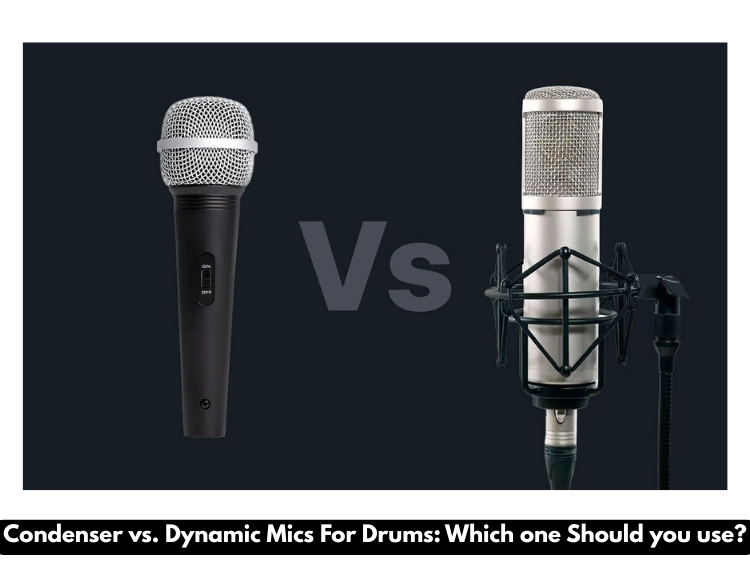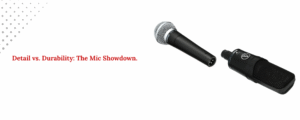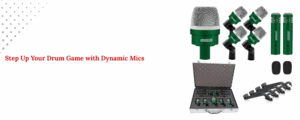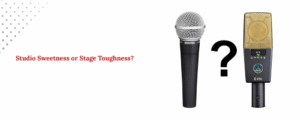The combination of mics, as condenser or dynamic, on your drums can spell the difference. All the microphone types have their own contribution to the kit. The clean details and the room sounds are well picked up by condenser mics and give your cymbals and overheads that shine. Dynamic ones, instead, do not even flinch when it comes to loud hits and piercing kicks. When to apply each of them also allows you to achieve the punch, clarity and balance your drums are meant to have, either live or in the studio.
Condenser vs. Dynamic Microphones
It is not only the tuning of the kit that enables you to achieve that excellent sound in drums, but also the selection of microphones. Every condenser and dynamic mic has an advantage, and there have been instances when knowing when to use one of them can really mean a world of difference, whether you are recording or on stage.
Condenser mics have a reputation for being detailed and sensitive. They capture the sparkle of cymbals and the sound of the natural room, which is why the drummers employ them as overheads, hi-hats and ambience. They require phantom power, and they are also fragile; hence, treat them carefully when on stage.
Dynamic mics are rugged and ready to take hard, high-impact hits. They work well on snare, tom, and kick close miking due to the ability to eliminate bleed and the ability to withstand cruddy gigs. Companies such as Shure, Sennheiser, Audix and 5Core have well-built dynamic microphones that produce quality sound and can last many years.
If you’re ready to upgrade, check out 5Core’s drum microphone kits for budget-friendly options that don’t skimp on quality. And if you’re buying for schools, studios, or bands, you can always get them in bulk at 5Core Business. Getting the right mix of mics helps your kit shine — every hit, every gig, every track.
How to Use Dynamic Mics on Drums
Many drum uses call for dynamic mics, especially when recording loud sources close up, such as:
- Kick Drum: People like dynamic mics like the Shure Beta 52 or the AKG D112 for the kick drum. They handle the kick drum shell’s strong, low-end thump and high SPL.
- Snare Drum: Tones like the Shure SM57 are standard for snare drums because they last a long time and can handle snare crack and attack.
- Toms: Dynamic mics also work well because they can handle the loud noise and punch of the toms.
Dynamic microphones are better than condenser mics because they can handle loud sounds without distorting, and they tend to reject off-axis noise, which lowers feedback from other drums.
Using Condenser Mics on Drums
Condenser mics are excellent for capturing the right details of the sounds that are superior and produce rapid variations of sound, such as the sound of drums. That is why they are favorable in some of the strategic locations.
Overheads record a bright, shiny image of your cymbals, hi-hats and the entire kit. A large- or small-diaphragm condenser is frequently used by drummers.
Mics placed at a distance record the natural echo of the room and make your sound of your drums deep and full.
Other engineers employ a condenser on the bottom of the snare, also, to record additional snap and clarity when recording both heads (top and bottom).
The fast response rate and the broad range of frequencies make the condenser mics shine when recording shimmering tones of cymbals or minute drum details. They are highly sensitive, though, and so can cope with unwanted background noise or bleed through with other instruments, a task made difficult in untreated rooms or loud live stages.
Do You Know When to Use Dynamic or Condenser Mics for Drums?
- Recording Studio: For overheads and room mics that want to record a realistic, full drum sound with lots of detail and air, condenser mics are often the best choice in well-controlled spaces. The kick, snare, and toms all use dynamics to give them more punch and last longer.
- Live Performances: Dynamic microphones are the best for drums because they are tough and don’t pick up noise. It’s good that they work well in busy places and can handle the high SPL of live drums without distorting.
Conclusion
Ultimately, it is usually best to cover various sections of the drum kit with each of the two types. Learning the differences between condenser and dynamic mics and how the two work in real life can get you the sound you desire in your drum recordings.
During the very beginning, you may purchase something like some good dynamic microphones to use as close mics and two condenser microphones to use near the overheads and as room captures. When you get more experienced in recording, it is possible to experiment with the position of the mic and the type to achieve the sound that makes your drum make a difference.




